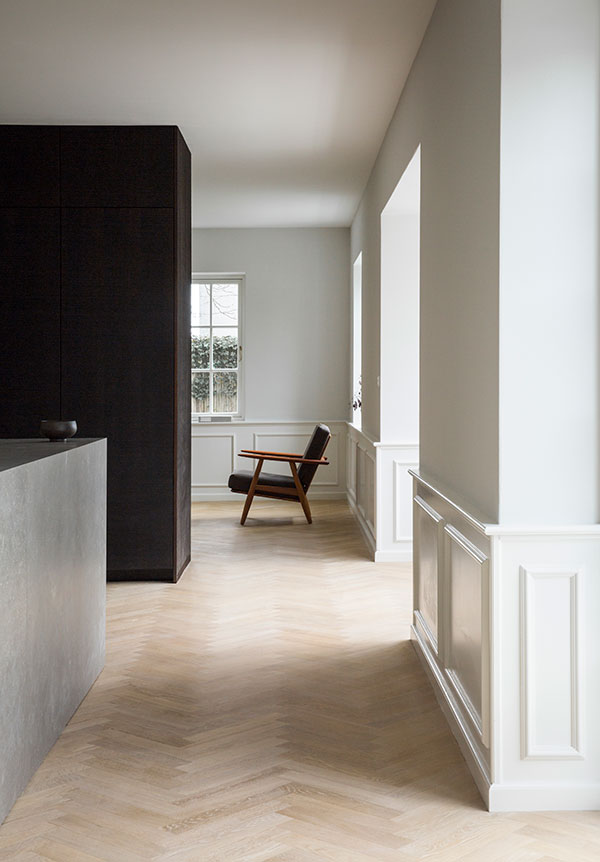一般的に、オーナー住戸付き賃貸住宅は最上階にオーナーが住み、下階を賃貸住戸としたりするものだが、ここでは再開発で引越しを余儀なくされたオーナー一家のために、設えられた「オーナー住戸」に皆で住むのではなく、将来の家族構成や社会の変化に耐えられる、新たな住まいを提案することとした。そこで、住戸にヒエラルキーをつくらず、全部屋をすべて異なるプランの賃貸住宅として設計することで、一家は各住戸を「個室」として選んで住むことができるようにした。
時間に対する柔軟さ(家族構成の変化に応じて建物内を移り住んでいける)を、専有部 / 共有部間を閉じるでも開くでもなく破線状のエッジとすることで身体に対する適度な距離感(今までの住まいと同じ感覚でそれぞれの気配を感じられる)を、それぞれ併せもつ「大きな家」である。
敷地は、国道沿いの大型マンションと密集する低層木造住宅のちょうど中間に位置する。コントラストのある周辺環境の粒度や肌理を調停するスケールとして、1,350mm間隔で配した310mm角の柱梁によるフレームを設定した。このシンプルな構造の中央に、余白・余地としての「めぐり土間」(屋根と吹き抜けをもつ共用階段)、その周囲に「オープンテラス」、「インナーテラス」、「居室」といった小さな居場所が入り交じり、内外が混交しながら連続する空間構成により、網を重ねた中に空気を含んだ建築をつくりたいと考えた。
「めぐり土間」は、インナーテラスや住戸を抜ける光や風により、淀みや奥のない、内部のような、外部のような明るさをもつ空間とした。さらに各踊り場にはベンチを設け、第2のリビングや書斎としての居場所にもなる。また、共用テラスにはアウトドアキッチンを設けた。さまざまなかたちをもつ13の住戸と共用部がにじみ合ってできる大きな気積の中で、各々の住人が三々五々、好きな場所で過ごすことのできるような計画とした。(井原正揮、井原佳代)
A large house-like apartment where residents and owners spend their time in their own way
An owner-occupied rental apartment building typically has its owner’s penthouse above the rental units.〈Hatsuse Mita〉is also an owner-occupied property with several rental units, but its spatial organization is much different. The owner’s family was forced to move out of their former residence due to the area’s redevelopment project. They needed a new home that can adapt to changes in their family structure and society. So instead of a residence for the whole family to live together, we proposed a plan in which every unit has a unique floorplan and can be offered as a rental unit or treated as an “individual room” of the family’s residence. In this non-hierarchical plan, the family can move from one unit to another, depending on the type of space they need at the time of transition in the future. Private and communal spaces are neither closed off nor open to each other but organized as edge pieces of a broken line. Hatsuse Mita is a “big house” in the sense that occupants can maintain the same privacy and intimacy level that the family enjoyed in their former home.
The site is situated amongst large-scale residential buildings along a major road and an area of low-rise wooden houses. Considering the high contrast of texture and sizes between these two areas, we gauged an intermediate structural scale: a frame built with 310mm square columns placed 1350mm apart. Set in the center of this simple structure, an open “Meguri-doma” connects all levels. “Open terraces,” “Inner terraces,” and “Living spaces” are placed around it in various patterns to mix inside and outside throughout the structure. We intended to add an airy feel to this layered net-like architecture.
“Meguri-doma (a covered stairwell / common corridor)” is designed to hold sunlight and allow the breeze to flow through the inner terraces and living spaces. By doing so, the stairwell becomes a fluid space that has both indoor and outdoor atmospheres. There is a bench in every landing area, which suggests alternative use of the space as a second living room or a study space. The communal terrace is equipped with an outdoor kitchen. Thirteen apartment units in various shapes and shared spaces form a multi-faceted volume, allowing residents to find a suitable space in the building for what they need at a particular moment. (Masaki Ihara, Kayo Ihara)
【Hatsuse Mita】
所在地:東京都港区三田5-10-2
用途:共同住宅・集合住宅
クライアント:愛宕長谷川
竣工:2019年
設計:ihrmk
担当:井原正揮、井原佳代、小野晃次郎
構造設計:ASA
設備設計:yamada machinery office
家具製作:寿々源
造園:en景観設計
施工:辰
撮影:稲継泰介
工事種別:新築
構造:RC造
規模:地上7階 地下1階
敷地面積:213.07m²
建築面積:143.07m²
延床面積:852.27m²
設計期間:2016.04-2018.05
施工期間:2018.06-2019.12
【Hatsuse Mita】
Location: 5-10-2, Mita, Minato-ku, Tokyo, Japan
Principal use: Housing complex
Client: Atago Hasegawa
Completion: 2019
Architects: ihrmk
Design team: Masaki Ihara, Kayo Ihara, Kojiro Ono
Structure engineer: ASA
Environmental design: yamada machinery office
Furniture: Suzugen
Landacape: en Landscape
Contractor: Shin
Photographs: Taisuke Inatsugu
Construction type: New Building
Main structure: Reinforced Concrete construction
Building scale: 7 stories and 1 below
Site area: 213.07m²
Building area: 143.07m²
Total floor area: 852.27m²
Design term: 2016.04-2018.05
Construction term: 2018.06-2019.12








